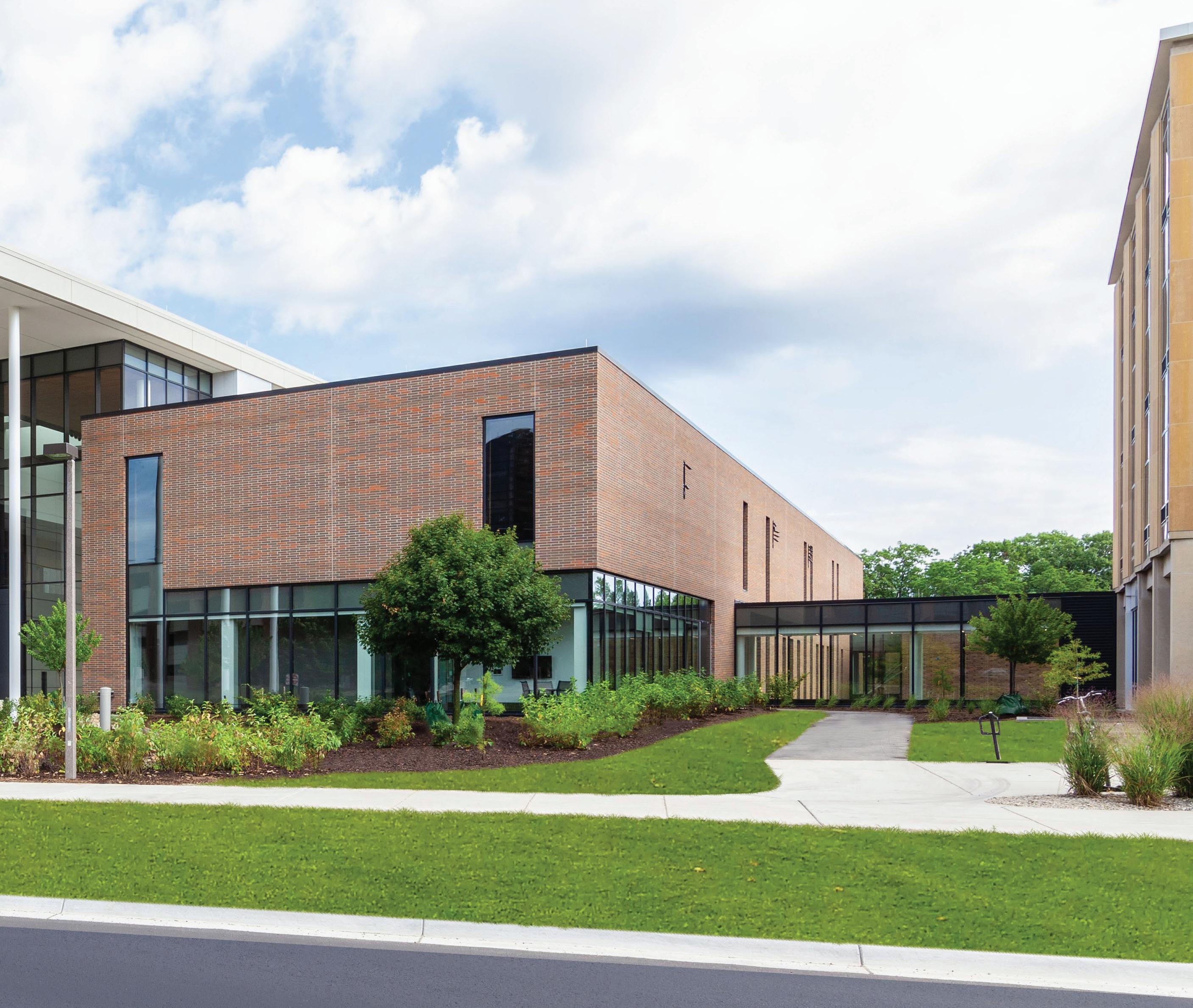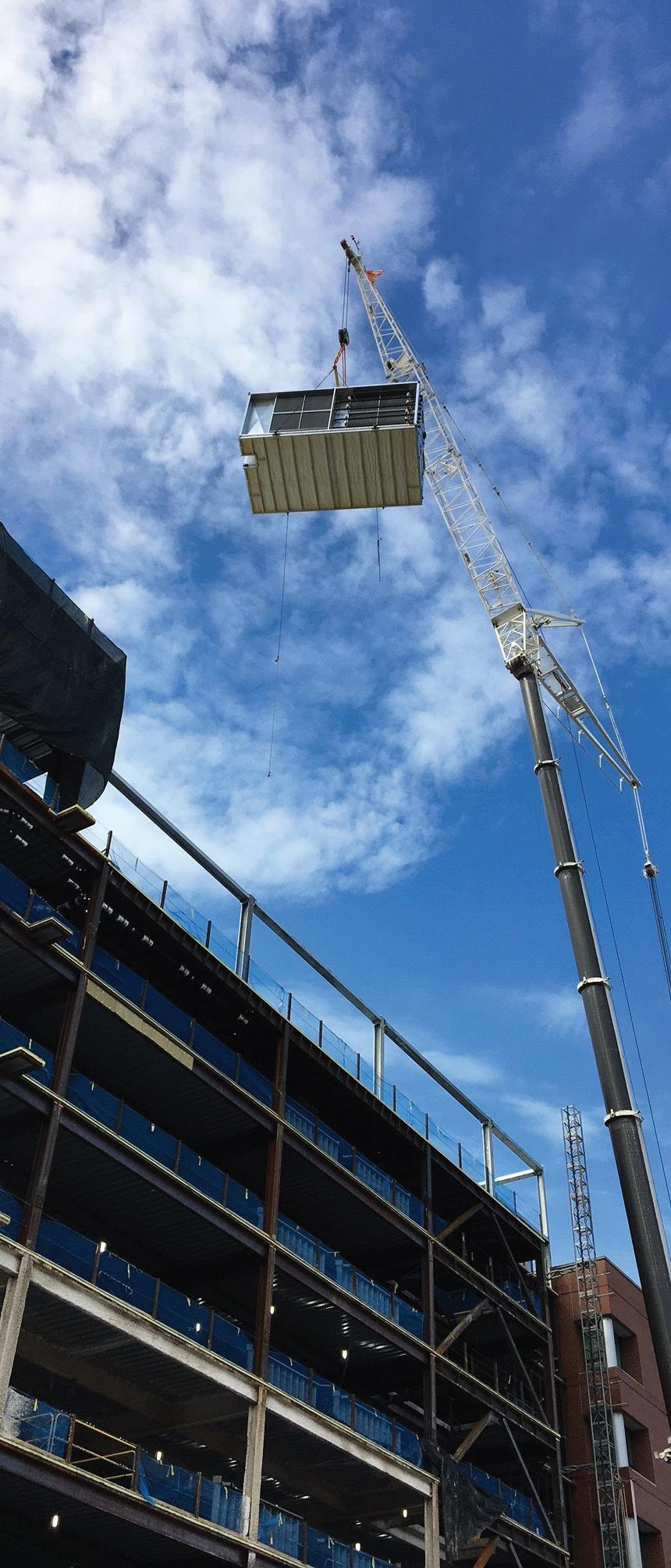
8 minute read
Where Cooperation is CONTAGIOUS
Where Cooperation is CONTAGIOUS
By Cynthia F. Young
In an industry that has traditionally relied on the design-bid-build approach to construction, the integrated project delivery (IPD) method inspires a different and innovative mindset. It has been proven to deliver a higher-quality product, on time, with minimal waste, and under budget.

The Edward J. Minskoff Pavilion
Photo courtesy of Clark Construction Company.
“We love being involved in IPD jobs,” says Matt Cramer, president of Dee Cramer Inc. in Holly, Michigan. “It’s the highest level of owner satisfaction as far as project delivery is concerned. And, in contracting, we operate in a silo environment. It’s a dogeat-dog world out there, and integrated project delivery is quite the opposite of that.”
Cramer says IPD jobs require and enforce a team-based environment that relies on collaboration between all levels of the project from the project director all the way down to field personnel. His company has completed eight IPD projects over the past several years, including the recent Edward J. Minskoff Pavilion for Michigan State University in East Lansing, Michigan.
What exactly is integrated project delivery?
“It’s a collaborative approach in our industry,” says Tom Martin, president of T.H. Martin Inc., Cleveland, Ohio, who has completed several IPD projects. “You’re working with the owner and the design team, facilities management, and other contractors. You’re working with your peers using a team approach, rather than just a ‘get it done’ approach.”
His company recently finished the IPD expansion of Akron Children’s Hospital, a seven-story, 230,000-square-foot Considine Professional Building that consolidated the facility’s outpatient services. “We can’t get out in front of or behind schedule,” Martin says. “Our design team and our labor partners must work together to maintain the schedule and keep the project under budget.”
Integrated project delivery also involves the use of building information modeling, lean principles, and a committed owner. It requires a formal contract among all major parties, a shared profit pool, actions that benefit all parties, and controlling costs through guaranteed maximum prices (GMP). When the project is complete, the profits are divided among the parties according to agreed percentage and performance.

The Edward J. Minskoff Pavilion
Photo courtesy of Clark Construction Company.
Integrated project delivery also offers a team-oriented environment on the jobsite, which brings the trades together and encourages the workforce to work smarter and more efficiently. “The field workers are happy with IDP,” Cramer says. “They notice the way everyone has to work together to make the project run smoothly and fee like they can thrive in a team-based atmosphere. With IPD, everyone is looking out for one another.”
Andy Schneider is a member of Local 7 and Dee Cramer Inc.’s lead foreman. Having managed crews on several IPD projects, Schneider says the workforce enjoys IDP projects and understands the benefits for workers and contractors.
“The owner ends up getting a higher quality project when the workforce is supported and the trades work together,” he says. “When it comes to the shared savings and schedule, everyone benefits in the long run.”
Schneider notes that the team-focused expectations that come with IDP projects help streamline processes onsite. “With IPD, the job is more sequenced and if you need help from another trade, for example, sharing ladders and lifts, it’s in everybody’s best interest to help each other out,” he notes. “It’s not as big a deal if you have to borrow equipment.”

The Minskoff Pavilion interior.
Photo courtesy of Clark Construction Company.

Crane lifting an AHU at Akron Children's Hospital.
Photo courtesy of T.H. Martin Inc.
Martin also includes his workers in the IPD process early in the construction process. “I think our union members enjoy IPD because everyone is there from the start,” he says. “A lot of times we also get our shop people and our field people involved in these meetings so they understand what methods are being used.”
Setting the tone for an holistic process early on results in strong buy-in from all team members. Contractors and the workforce work from a collective understanding of the project and what the customer is looking for from start to finish. For some, it is an educational procedure from which they learn a great deal about how jobs are secured, bid, and run.
“They also like that they are not going to get blindsided on any issues,” Martin says. “There are fewer hiccups and delays. They know the schedules and demands required. In regular construction, the owners are constantly changing things, but IPDs eliminate constant change orders and delays on a project.”
Besides working from the same game plan and adhering to the same schedule, team members are collectively working to achieve incentives, shared project goals, and maximized value for the owner, who is also involved from the project’s beginning.
“IPD really provides more value for the owner because they’re involved during the process and are making educated decisions on how they are spending their money,” Cramer says.
Design-build-bid projects are different in several ways, not the least of which is the contract structure. In those projects, it’s every trade for himself, says Nick Henne, project manager with Clark Construction Company, who worked with Dee Cramer Inc. on Michigan State University’s 100,000 square-foot development, the Edward J. Minskoff Pavilion.
“They have tunnel vision,” he adds. “They are not always focusing on the trade partners around them and what they could do better to help the project.”
Henne notes that unions are a natural fit for IDP projects because they have a natural inclination towards team work and positive group dynamics. “The big thing is the teamwork,” he says. “The design and construction phases are require a great deal of collaboration with the principal partners.”
This team spirit permeated T.H. Martin’s IPD work with the Akron Children’s Hospital, and Kurt Vermilye, member of Local 33 and senior project manager and sheet metal superintendent, took note. “There were partnerships between all the trades,” Vermilye says. “You may have a little argument on a traditional job, but this job took all that away. Everybody bought into the same thing.”

Mechanical rack installed in Akron Children's Hospital.
Photos courtesy of T.H. Martin Inc.

Fully assembled AHU in Akron Children's Hospital.
Photos courtesy of T.H. Martin Inc.
The crew was unfamiliar with IDP when the project began and needed some encouragement to get on board. Varmilye says sharing all aspects of the job—including any potential problems— and increases safety were the most effective selling points with the workforce.
“The workers have a saying: it’s a ‘no blame, no shame’ atmosphere, meaning you’re not going to point a finger because we’re all one team,” he says. “Everybody bought into that.”
The construction company also focused on safety. “First thing in the morning we would meet and learn a safety tip and then go right into stretching and flexing,” Vermilye says. “We were fortunate to have all good contractors. The whole thing was a great experience.”
With IPD, there are a few downsides—manpower and long meetings. “The problem with IPD is that it really pigeonholes some of your good people in these long meetings, two days in one week,” Martin says. “They’re not able to bid other jobs and work on other projects. That’s why contractors who do IPDs are more diversified and have additional resources within their companies.”
What advice would contractors give to others thinking about getting into IPD?
“With a very large pre-construction effort, it is the most intensive time period,” Cramer says.
“Make sure you have the resources and humanpower to engage,” Martin says. “Have enough personnel with CAD and BIM operators on your project management team. Have a good accounting system that can project correct billings on a monthly basis, and pick the right foreperson who is willing to communicate and collaborate with other trades and the customer. That’s key.”
“Definitely pick the right team,” Henne agrees. “Pull your team together upfront and make sure those individuals get the process. Don’t rush into something that might jeopardize the results in the project. Take your time, make sure everything is set and things should go off without a problem.” ▪
Cynthia Young is an award-winning journalist who has written hundreds of articles for newspapers, websites, and magazines, including profiles, features, and news articles in the construction, architecture, environmental, travel, hospitality, and food and home industries.
Give and Take
Integrated project delivery requires teams to give (and take) to improve the overall project, and to some that sounds like the kind of “optimizing” that can reduce or threaten person-hours—but it doesn’t have to be that way. In fact, IDP is more about leaning a project, which calls for streamlining, efficiency, and productivity— all qualities a talented workforce bring to the table.
“In sheet metal, we’re taught right away to stack 20 sheets together and cut them all at the same time,” said Tim Carter, business manager from Local 66 out of Everett, Washington. “We don’t think of it as a lean process, but it is. The lean process affects more than productivity. It affects safety and morale. It’s permeated a lot of different aspects.”
It’s imperative each team member understand their results in the greater good of the project, even when they may be required to pass normal tasks to other responsible parties on the team. When striving for innovative ideas, high functioning teams need strong partners. This will require team members to be flexible, knowledgeable, and always available. This process will show strengths and weaknesses of team members, pushing the stronger members to work harder.
“I really believe – and tell the guys – lean is something they do every day,” said Henry Nutt, sheet metal general superintendent for Southland Industries, which has adopted lean construction as part of the company philosophy. “This is just a formal way to capture it.” IDP (and other lean practices) require more collaboration and time in the meeting room, but this works out to better efficiency in the long run. This planning leads to fewer surprises, said Tom Soles, executive director of member services and market sectors for SMACNA.
“It cuts down on all the inefficiencies that occur on a construction project when people aren’t communicating and working together,” he says. “Forepersons and superintendents are in these meetings instead of on the job site. There will be more time invested up front but the project should go smoother.” ▪







